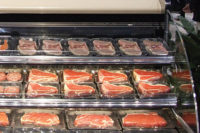 Air doesn’t belong in a refrigeration system, and if it gets in, it will cause problems. Air can enter a refrigeration system in many ways, including through tube, gasket, or flange leaks; poor charging procedures; poor recovery or recycling procedures; or by forgetting to purge hoses when accessing systems.
Air doesn’t belong in a refrigeration system, and if it gets in, it will cause problems. Air can enter a refrigeration system in many ways, including through tube, gasket, or flange leaks; poor charging procedures; poor recovery or recycling procedures; or by forgetting to purge hoses when accessing systems.
If air gets into a system, it will collect in the top of the condenser and be trapped. Air is a non-condensable and cannot be condensed like refrigerant vapors. The liquid seal (subcooled liquid) at the bottom of the condenser will prevent air from leaving the condenser. Air will cause a reduction of condensing surface area and cause high condensing (head) pressures.
Air can enter the system through a leak in the low side of the refrigeration system. Refrigerant leaks will eventually lead to an undercharged system. Severely undercharged systems will run vacuums in the low side. These vacuums will suck in air from the atmosphere because the system’s low-side pressure is lower than the atmospheric pressure.
Know the Symptoms
The symptoms of air in a refrigeration system are:
• High discharge temperature;
• High condensing (head) pressure;
• High condenser subcooling;
• High condenser split;
• High compression ratios;
• Normal to slightly higher evaporator (suction) pressures;
• Normal superheats; and
• High amp draws.
Let’s take a closer look at each of these.
High Discharge Temperatures — These are caused by high compression ratios. High heats of compression are associated with high compression ratios. High compression ratios are associated with high condensing (head) pressure. The compressor has to compress suction vapors through a greater pressure range; thus, more heat is generated.
High Condensing (Head) Pressures — High head or condensing pressures are generated from the air taking up condensing surface volume at the top of the condenser. Because the air stays at the top of the condenser and doesn’t condense, it leaves a smaller condenser to desuperheat, condense, and subcool the refrigerant.
High Condenser Subcooling — The elevated condensing temperatures and pressures make the subcooled liquid in the bottom of the condenser hotter. Now there is more of a temperature difference between the subcooled liquid and the ambient to where heat is rejected. This will increase the rate of heat transfer from the subcooled liquid because the temperature difference is the driving potential for the heat transfer to take place.
The higher subcooling does not necessarily mean there is more liquid at the condenser’s bottom, it just means there is more cooling of the same amount of liquid to make the temperature difference greater. Remember, condenser subcooling is a temperature difference between the liquid temperature at the condenser outlet and the condensing temperature.
High Condenser Splits — Because the air is sitting at the top of the condenser, causing elevated condensing pressures and temperatures, the temperature difference between the surrounding ambient and the condensing temperature will be high. This temperature is defined as the condenser split.
High Compression Ratios — The higher condensing (head) pressures will cause the compression ratio to increase, causing low volumetric efficiencies and loss
of capacity.
Normal to Slightly Higher Evaporator (Suction) Pressures — A system’s thermostatic expansion valve (TXV) will control superheat as long as the pressure ranges of the valve are not exceeded. It takes a very high head pressure to exceed the pressure range of most TXVs. The TXV may overfeed a bit on its opening strokes because of the greater pressure difference across its orifice, giving it a slightly higher capacity. This may give the evaporator a suction pressure that’s a bit higher than normal.
If the amount of air in the condenser is extreme, the compression ratio will skyrocket and cause very low volumetric efficiencies. This will cause a low capacity, and the box temperature may rise. This added heat in the box may cause evaporator pressure to increase because of the added heat load.
Normal Superheats — As mentioned earlier, the TXV will try to maintain evaporator superheat as long as the valve’s pressure range is not exceeded. The opening strokes of TXV may momentarily overfeed the evaporator, but it will start to gain control shortly afterwards.
High Amp Draws — The high compression ratio will cause a greater pressure range for the suction vapors to be compressed. This will require more work from the compressor and increase the amp draw.
Publication date: 6/1/2015
Want more HVAC industry news and information? Join The NEWS on Facebook, Twitter, and LinkedIn today!







Report Abusive Comment